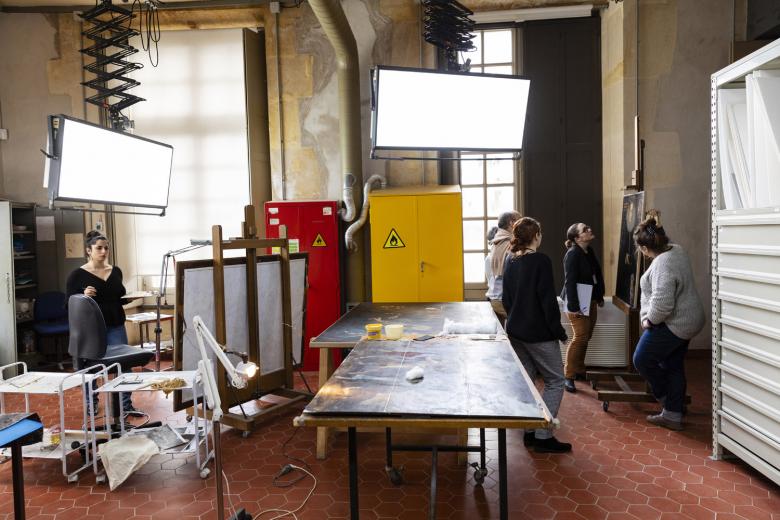Programme de recherche dans le cadre de l'accès FIXLAB de l'infrastructure européenne IPERION CH
Publié le 22/10/2019
For the english version, please scroll down
Für die deutsche Fassung, siehe unten
L'ivoire préhistorique au temps des accélérateurs de particules
Sorti en version DVD en juillet 2019, ce film illustre les analyses chimiques et l'imagerie d'objets en ivoire de mammouth à la nouvelle ligne microfaisceau New AGLAE. Les recherches portent sur l'analyse non-invasive des éléments traces dans les objets préhistoriques en ivoire de mammouth qui peuvent être considérés comme marqueurs du comportement humain au temps des premières sociétés d'Homo sapiens en Europe.
Le film présente des analyses non-invasives par émission de rayons X et gamma induite par un faisceau de protons (PIXE-PIGE) réalisées à la nouvelle ligne d'imagerie de l'accélérateur New AGLAE sur les objets préhistoriques en ivoire de mammouth. Ces analyses sont réalisées dans le cadre d'un programme transdisciplinaire franco-allemand combinant chimie analytique et archéologie préhistorique dirigé par Ina Reiche, Directrice de recherche au CNRS, IRCP-C2RMF. L'ivoire de mammouth avait une grande importance sociale et socio-économique parmi les premières sociétés d'Homo sapiens en Eurasie il y a environ 40 à 30 000 ans. Il a été utilisé pour créer des parures ainsi que les premiers objets tridimensionnels d'art figuratif dans le monde. Les analyses des objets en ivoire permettent d’obtenir, en plus des observations stylistiques, des informations sur le savoir-faire technique et les modes d’approvisionnement de la matière première des hommes préhistoriques. A partir de ces recherches il est possible de remonter à la fonction des ivoires aux temps préhistoriques et aux phénomènes d’altération.
Le film illustre la démarche scientifique et ouvre des perspectives sur d'autres recherches et études innovantes dans le domaine des sciences du patrimoine.
Particle physics on prehistoric ivory
Released as DVD in July 2019, this film illustrates the chemical analysis and imaging of mammoth ivory objects at the new New AGLAE microbeam Line. The research focuses on the non-invasive analysis of trace elements in prehistoric objects made of mammoth ivory that can be considered as markers of early human behavior at the time of the first Homo sapiens societies in Europe.
The film features non-invasive proton beam-induced X-ray and gamma ray emission (PIXE-PIGE) analyzes at the New AGLAE imaging beamline on prehistoric mammoth ivory objects. These analyzes are carried out as part of a transdisciplinary Franco-German program combining analytical chemistry and prehistoric archeology lead by Ina Reiche, CNRS research director at IRCP-C2RMF. Mammoth ivory was of great social and socio-economic importance among the earliest Homo sapiens societies in Eurasia about 40 to 30,000 years ago. It has been used to create adornments as well as the first three-dimensional objects of figurative art in the world. The analyzes of ivory objects make it possible to obtain, in addition to stylistic observations, information on the technical know-how and modes of supply of the raw material of prehistoric men. From this research it is possible to go back to the function of ivories in prehistoric times and alteration phenomena.
The film illustrates the scientific procedures and open perspectives on further innovative research and studies in the field of heritage science.
Teilchenphysik an steinzeitlichem Elfenbein
Diese im Juli 2019 erschienene DVD zeigt die chemische Analyse und Bildgebung von Mammut-Elfenbein-Objekten an der neuen New AGLAE Mikrostrahllinie. Der Forschungsschwerpunkt liegt auf der nicht-invasiven Analyse von Spurenelementen in prähistorischen Objekten aus Mammutelfenbein, die zur Zeit der ersten Homo sapiens in Europa als Marker frühen menschlichen Verhaltens angesehen werden können.
Die DVD enthält einen Film über nicht-invasive Analysen mittels Protonen- induzierter Röntgen- und Gammastrahlenemission (PIXE-PIGE) an der New AGLAE Imaging Beamline an prähistorischen Mammut-Elfenbeinobjekten. Diese Analysen werden im Rahmen eines transdisziplinären deutsch-französischen Programms durchgeführt, das analytische Chemie und prähistorische Archäologie kombiniert und von Ina Reiche, CNRS Forschungsdirektorin am IRCP-C2RMF geleitet wird. Mammutelfenbein war von großer sozialer und sozioökonomischer Bedeutung unter den frühesten Homo-Sapiens-Gesellschaften in Eurasien vor ungefähr 40 bis 30.000 Jahren. Es wurde verwendet, um Schmuckstücke sowie die ersten dreidimensionalen Objekte der figurativen Kunst in der Welt zu schaffen. Die Analyse von Elfenbeinobjekten ermöglicht es, neben stilistischen Beobachtungen, auch Informationen über das technische Know-how und die regionale Vielfalt der Elfenbeinversorgungsstrategien unserer Vorfahren des Rohmaterials zu erhalten. Aus dieser Forschung ist es möglich, auf die Funktion von Elfenbein in prähistorischen Zeiten und auf Alterserscheinungen Rückschlüsse zu ziehen.
Der Film veranschaulicht die wissenschaftliche Herangehensweise und eröffnet Perspektiven für die weitere innovative Forschung und Untersuchung auf dem Gebiet der Kulturerbeforschung.
.


